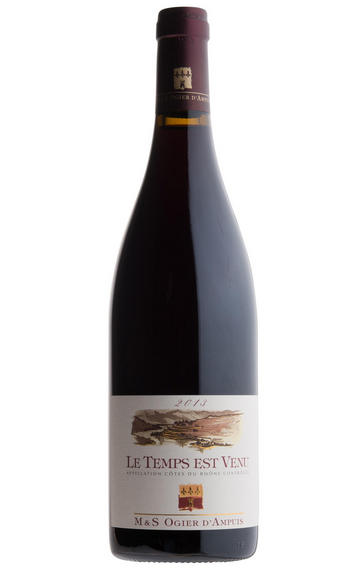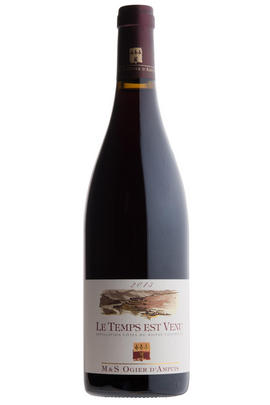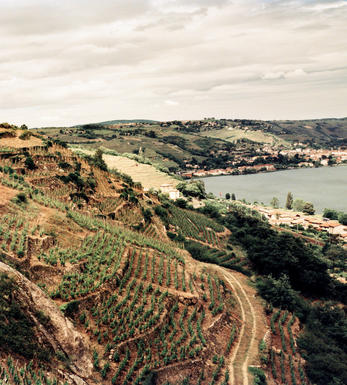
2013 Côtes du Rhône Villages, Plan de Dieu, Le Temps Est Venu, Dom Ogier

About this WINE

Domaine Stephane Ogier
The Ogier family had been established growers in Ampuis for over seven generations, but it was only in the 1980s that they began vinifying their own grapes. Stéphane joined the family estate in ’97, working alongside his father Michel, before taking over in 2003.
Heralded as the face of the Northern Rhône’s new generation, Stéphane continues acquiring new parcels and trying new techniques. He brings a Burgundian approach to the region’s terroir from his studies in Beaune. He works with multiple lieux-dits, vinifying each separately and using oak sparingly. This allows the characteristics of each to show. He releases many wines as single lieu-dit bottlings later in the year and others he blends, selecting from different barrels to build a style representative of both his vision and the vintage. Stéphane’s latest investment includes vineyards in Rasteau, Cairanne, and Plan de Dieu in the Southern Rhône, bringing his total land-ownings there up to 50 hectares, all destined for his Côtes-du-Rhône offering.

Rhône
Wine has been produced in the Rhône Valley for over 500 years, with some of its vineyards being amongst the oldest in France. Syrah rules over the south with a mix of Mediterranean grapes, while in the north, the two stars are Hermitage – grown on an imposing granite hillside above the town of Tain and best put away in the back of the cellar for a decade – and Côte-Rôtie, a star appellation made famous by Guigal's single-vineyard wines, yet also home to dozens of fine producers as yet less well known. The sheer hillsides overlooking the river have to be terraced to make production possible.
St Joseph and Cornas also provide wines of weight and worth, but the best source for good value is Crozes-Hermitage, a satellite appellation which has come alive in the last few years with the arrival of young blood.
The river valley widens out south of Valence into Côtes du Rhône country on the windy alluvial plains and the lower slopes of the hills. It is a most imposing sight during the cold, clear, blue skies of Mistral conditions. The best of the wine villages of the Côtes du Rhône have been promoted to their own appellations - Vinsobres, Vacqueyras - close in quality to the better known Gigondas.
The king of the southern Rhône is Châteauneuf-du-Pape. Here the galets roulés, rounded rocks from the ancient river bed, provide the context for gloriously rich red wines that are redolent of the heat and herbs of the south, and enhanced by the complexity which comes from blending several grape varieties. Thirteen are permitted in all, but Grenache usually dominates, along with Syrah and Mourvèdre in support. A fine vintage needs eight to 10 years cellaring for best results.
If your taste runs to fuller, richer, relatively exotic white wines, then perhaps a white Hermitage or Châteauneuf-du-Pape from the Rhône Valley would suit better, or else a marvellously perfumed, heady Condrieu - headquarters of the Viognier grape.

Southern Rhône Blend
The vast majority of wines from the Southern Rhône are blends. There are 5 main black varieties, although others are used and the most famous wine of the region, Châteauneuf du Pape, can be made from as many as 13 different varieties. Grenache is the most important grape in the southern Rhône - it contributes alcohol, warmth and gentle juicy fruit and is an ideal base wine in the blend. Plantings of Syrah in the southern Rhône have risen dramatically in the last decade and it is an increasingly important component in blends. It rarely attains the heights that it does in the North but adds colour, backbone, tannins and soft ripe fruit to the blend.
The much-maligned Carignan has been on the retreat recently but is still included in many blends - the best old vines can add colour, body and spicy fruits. Cinsault is also backtracking but, if yields are restricted, can produce moderately well-coloured wines adding pleasant-light fruit to red and rosé blends. Finally, Mourvèdre, a grape from Bandol on the Mediterranean coast, has recently become an increasingly significant component of Southern Rhône blends - it often struggles to ripen fully but can add acidity, ripe spicy berry fruits and hints of tobacco to blends.


Buying options
Add to wishlist
Description
This well-named southern cuvée is sourced from vines on the equally well-named Plan de Dieu and one or two from the village of Violès. Mainly Grenache, but with, as one would expect and hope, a quarter Syrah in the blend, this is rich and spicy. Whole bunch fermentation and cement vat maturation underline the fruit quality and the impressive concentration of this wine.
Simon Field MW - Rhône Buyer
Stéphane has come a long way in the 12 years or so that I have known him: he now has two children, an enviable reputation and a construction project to the south of Ampuis which will result in a winery to rival that of Messrs Guigal. He has also been buying land, which is no mean feat in Côte Rôtie. The challenge of 2013 centred on the cool weather in the middle of the season. Very late green harvesting and then a rapid harvest before the rains in October were key. I recall visiting during the harvest and witnessing a maelstrom of carefully choreographed activity, if you will pardon the apparent contradiction. The effort has certainly paid off. Starting off the 2013s, the 2013 Cotes du Rhone Le Temps Est Venu comes all from the Plan de Dieu and is a blend of 60/40 Grenache and Syrah (with a splash of Mourvedre) that was fermented with 100% whole clusters and aged in cement tanks. It’s a solid 2013 that has a forward, fruit-loaded and delicious style to go with plenty of peppery herbs, underbrush and sweet kirsch and darker fruits. It’s well-made 2013 that will provide lots of pleasure over the coming 4-5 years.
Jeb Dunnuck - Wine Advocate Issue#216 Dec 2014
wine at a glance
Delivery and quality guarantee